Editor’s note: For the second-straight year, we’re presenting another 12-day holiday gift guide, brought to you by the one and only “FBD”, our gear-review guru. Kicking the series off, recommendations for recovery gifts to keep you and your ski buddies on the trails and injury free. See also: Day 1 | Day 2 | Day 3 | Day 4 | Day 5 | Day 6 | Day 7
***
Day 8: Lighting Systems
You’re going to see a bit of a theme today — lighting systems. I suppose that’s why today’s column is entitled, “Lighting Systems”. I’ve found that actually being able to see while skiing is a real plus, so today we’re going to “focus” (prepare yourself, too, as this is just one of many bad puns on vision and optics — I’ve said it before and I’ll say it again, I’m an unapologetic science geek) on how to safely navigate the tracks when The Man forces you out under the cover of darkness.
Headlamps have come an amazingly long way in a relatively short period of time, as it seems like it was just yesterday that I was slogging along, lost in the mountains of Santa Monica at 3 a.m. in a 24-hour adventure race, with all of the headlamps on my entire team dead. We had backup lights with the approximate lumens of a candle and let me tell you, you learn a lot about how to handle your mountain bike when you are ripping down descents at 30 mph in the pitch black, after having already raced for 16 hours. It was right then and there that I decided that I would never be without a good headlamp again.
So for a total gear nerd like me, headlamps are a total slam dunk, but what about for all of your “normals” out there (well, insomuch as any nordic skier is normal)? Let me ask you a few questions: Do you have power in your home? Does that power sometimes go out? Does it get dark where you live? Do you sometimes need/want to train at night? Do you think it is even remotely possible that you or a loved one could some day have a mechanical or some other issue with your car when it’s dark? If you’ve answered yes to any of these questions, you need a headlamp, and a good one at that.
I’ve probably own/have owned more than 30 of these over the years. I’ve bought them, won them in races, received them free when buying base layers in Switzerland, helped companies with product testing — you name it. Part of my love affair with this wonderful device stems from their utility: not only are these babies essential for ANY type of training in the winter when work demands and scarcity of daylight conspire to send me out in the dark (an all too frequent occurrence), but there’s also thrill of rediscovering trails that you’ve ridden literally thousands of times in daylight on your mountain bike that take on a completely different dimension in the dark. Then there’s also 24-hour racing. Or even just simply trying to commute home from your office at night without being killed by a distracted motorist. For many of us out there, fighting a good fight, frantically clinging to whatever shred of fitness that we’ve been able to carve out given our brutal work schedule, the bike commute can be the difference between getting in some training and doing nothing at all, and nighttime bike commuting simply cannot happen without a good lighting system.
The list goes on and on: back when we used to get snow in the winter and I could pry Smullin away from shopping for disinfectant wipes in his mom jeans with his squad, we’d skin up the ski mountain at “O-Dark Thirty” on Dong Patrol (how Steamboat bros refer to Dawn Patrol, because it’s usually nothing but about 10 smelly dudes doing this) with nothing but our headlamp and shining personalities to light the way. For anyone who has ever spent any time with either myself or J-Smu, this obviously meant that we were quite reliant on the headlamps.
Not to beleaguer this point (but, this IS my speciality), but this realm goes even beyond fitness applications. As noted above, if you’re trying to navigate your house after an all-too-frequent East Coast power outage, get your stupid Great Dane outside in the midst of yet another midnight bathroom emergency, or simply find your way from the very inconveniently placed wall switch to your bed in your pathetic West Yellowstone cabin (because any time that you can work Bugs Bunny into a story, you know you are doing something right) in your equally pathetic and largely futile attempt to get faster on your skis, headlamps are nothing short of essential. I have one in all of my cars, multiple in each home, and an extremely wide assortment for all of my various athletic endeavors. It is therefore with great pride that I present a wide array of options for essentially all of your needs.
***
Under $29
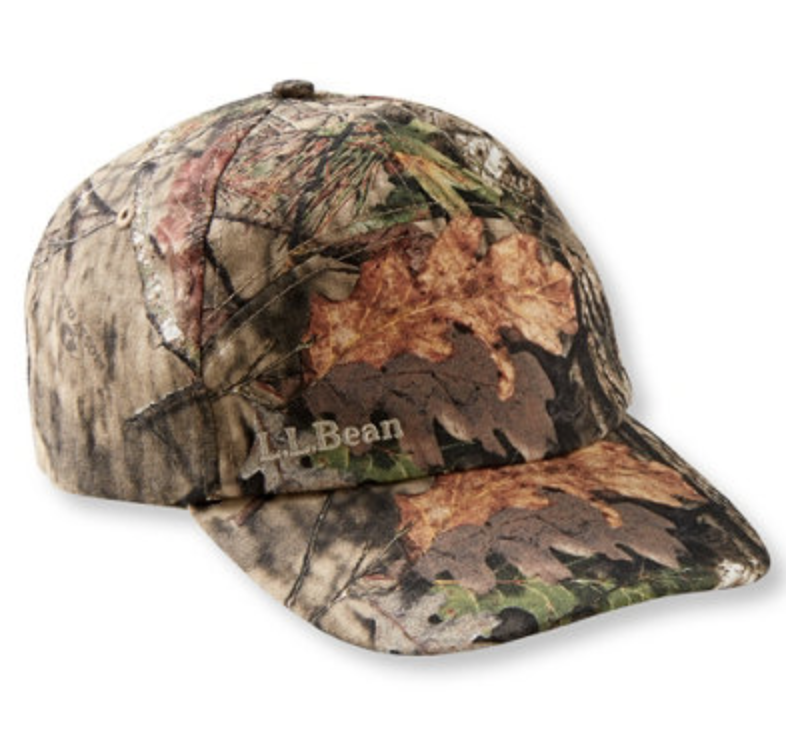
Squeaking in right under the $29 cutoff (at $29) are two of my favorite hats: the L.L. Bean Pathfinder series. There’s a ball cap and beanie option and quite frankly, you should buy both (it still gets dark in summer, remember, and please don’t be one of those beanie-wearing hipsters. Winter? Sure, rock the beanie. Summer? That’s ball-cap weather, you freakin’ weirdo. Please don’t be “that guy”).

Both of these hats are the ultimate dog-walking, evening-hiking, survive-the-walk-home-from-the-bar hats. With 48 lumens of light, either of these chapeaus will help you both see and been seen nicely. As an added bonus, the entire lighting system is so well-hidden in the hat that it is essentially undetectable when not in use, so you can wear this hat on both the daylight walk to the bar and the nighttime walk home without looking like the gear geek that you are. On that latter point, though, not to worry, you’ll have the last laugh when your too-cool-for-school conventional headwear comrades twist an ankle on the obstacle that you neatly avoided.

Petzl is one of the big boys in the lighting game and they have many nice options, from a featherweight E+ light, to the more multipurpose Tikka, to the feature-rich Reactik +, and trust me when I say that you need one of these lights.
As noted in my compelling, colorful, and comprehensive introduction, you don’t need a light, you need lights, with an ‘s’. (Just like, “It wasn’t a cop, it was cops, with an s’” at 7:30)
Specifically designed for emergency use and featuring amazing long-term battery life for extended storage, the E+ is a steal at $30. You absolutely should have one of these (or its equivalent). I personally like to go for a bit more horsepower, but you at a bare minimum you should be equipped with one of these for every auto, home, and backcountry outing. They are small, light, cheap and even have a cool carrying case, making it extra easy to tuck away until you really need it. And when you need it, boy will you be glad you have it.
***
$30 – $99
More Everyday Headlamps
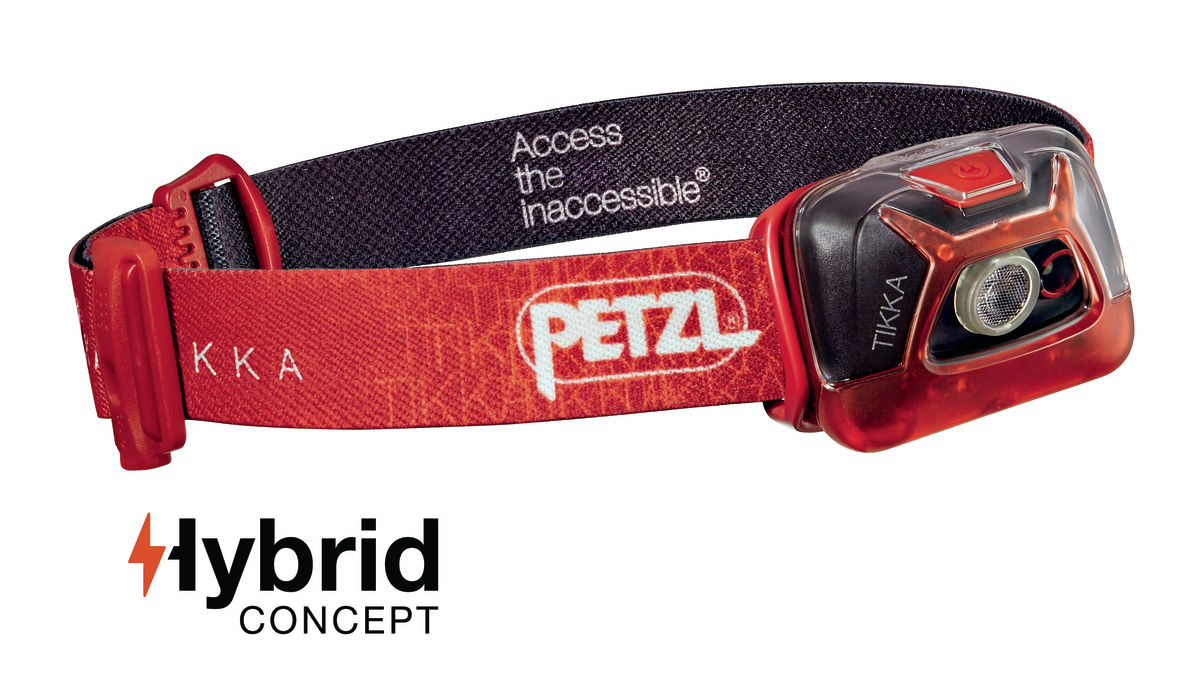
Moving up the food chain is the Tikka. Petzl summarizes its utility nicely as, “a compact headlamp for proximity lighting and some movement.” With 200 lumens it’s not exactly going to light up the night sky, but it’s cheap, powerful, and versatile. Since I’m getting more and more lazy with each passing day, I’m going to again let Petzl describe it: “it is practical for outdoor activities like camping or trekking, or for traveling, and also for daily activities and projects around the house. The phosphorescent reflector helps you find it in the dark, and the red lighting prevents members of a group from blinding each other.”
I’m lifting that description not just because I’m too bloated and apathetic to write (though that is certainly a big factor), but also because I find that description to be quite apt. This is my “go-to” light for the car, nightstand, kitchen utility drawer, etc. It’s not that much bigger than the E+, but it has four times the power and is thusly much more useful.
***
$100 – $299
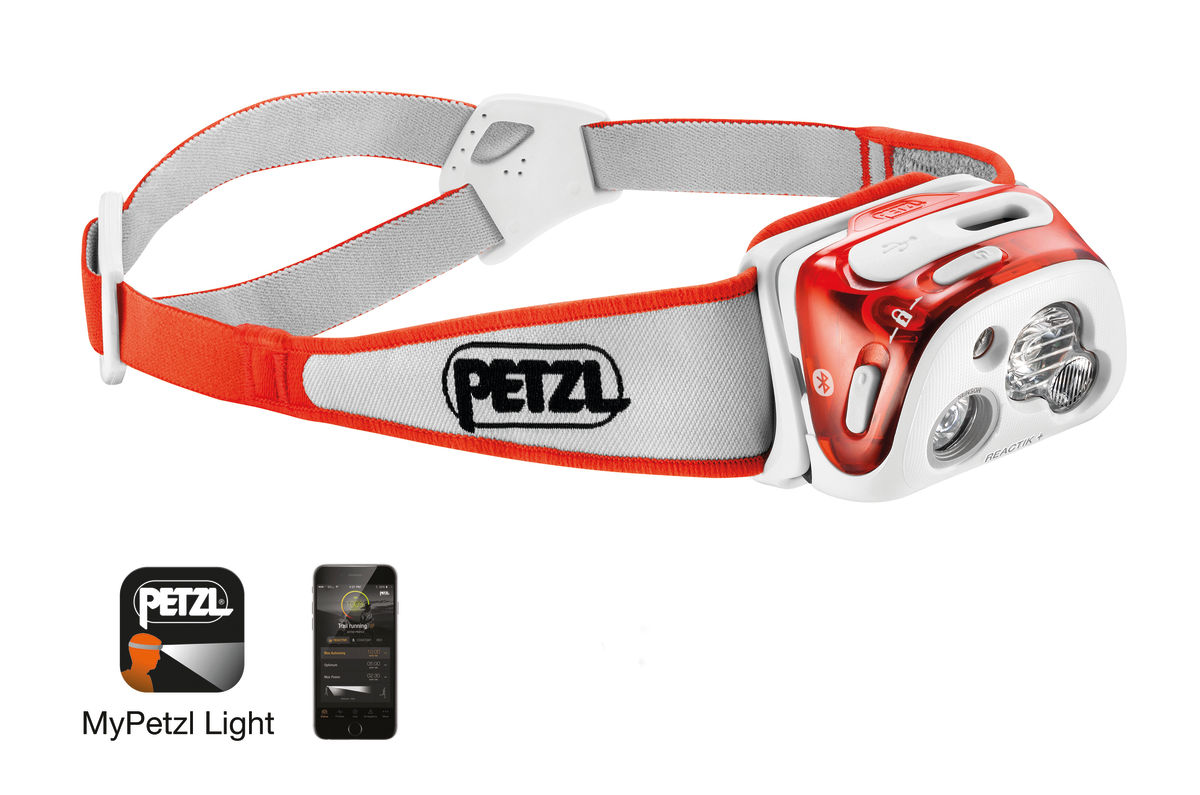
Finally, the one sent to me by Petzl (that’s right I bought the rest of these with my own, hard-earned money, because that’s just how dedicated I am to making you very needy people happy) was the Reactik +. This lamp has 300 lumens of power and that’s a noticeable improvement over the two models described above. It it also programmable, has the option to run on disposable or rechargeable batts, and features several lighting modes.
Overall, this is also a great light, but is it bright enough for skiing? In my opinion, no. It will work in a pinch or maybe if you’re on tracks that have some other ambient light, but to be perfectly blunt, this light sort of finds itself in that dreaded “no man’s land” of kinda bright, but kinda not. Somewhat cheap, but not really. I used it on a few skis and it is most certainly better than nothing, but my advice is to get a few Tikkas for “everyday” use, then buck up for one of the big boys that we’ll talk about in a second for skiing.
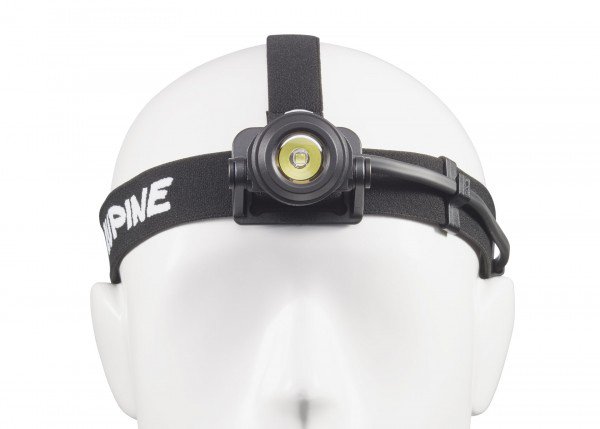
Here is where the story gets good. If you want to do anything active at night (nah….too easy), you’re going to want to buy one of the two lights that I’m about to describe. Both are made by a relatively small company in Germany called Lupine, and as you might expect from a German company, these are exquisitely designed, engineered, and meticulously machined pieces of equipment.
Option one is the Neo. This is probably one of the best all-around lights that I have ever used. It has 900 lumens of light, which is quite frankly amazing. To put that in perspective, this is three times as much light the the fanciest Petzl that we tested. That’s a lot. As you can see from this video, my test team and I were able to ski around on pitch-black trails at 9,000 feet and see every single nook, cranny and turn (not to be confused with kooks, trannies and burns, which is a completely different discussion altogether).
Overall, it’s just a very well-thought-out light. It has a diffuser, so you can use it inside a tent, car, or house, without blinding everyone around you, and this is also good if you are alone but you need more moderate, even light: think of it as a lens cover that converts a spotlight to a more general, “room” light. This adaptor is also available in green, which has the advantage of making it easier for your eyes to maintain their night vision.
You can also order all sorts of mounting options and accessories for handlebars, helmets, headbands and probably anything else that starts with a ‘h.” I love this light. Does it cost more than the Petzl? Yes, but if you ski, run, or ride more than once or twice per year at night, this light is well worth the money. Going head to head on the trails at night, it wasn’t even close between these two systems.
$275 on LupineNorthAmerica.com
***
Over $300
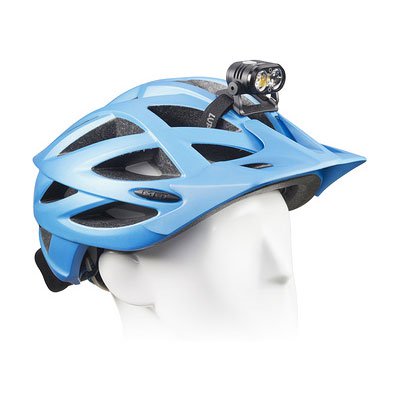
You’ve undoubted heard the trite cliche, “Go big or go home,” but what if your light has conked out and you can’t make it home? Enter the Big Daddy of all lighting systems, the Lupine Piko 4. How big is this daddy? How about 1,800 lumens big? How does that grab you? Er…..light you? Hmm, that sounds weird, too. Let’s come back to this later.
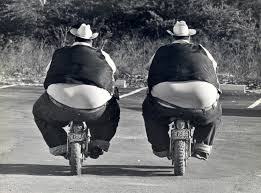
In short, this thing is the sh*t. It’s got 1,800 lumens and yes, I know, I’ve already said that, but that is so substantial I believe it merits repeating. Why? Glad you asked.
First of all and most obviously, this means that when you need to, you can paint the sky (or trail or road or whatever) with a super clean, wide beam of light. Since this is a pricey recommendation, I wanted to be sure I was fully on point with this system, so I did a some testing with the whole Lupine tech team. They gave me an earful on the different wavelengths of light that they are using as compared to their competitors, making the beam on Lupine lights much “cleaner.” There’s some really cool research out there this issue, but it can make for some pretty heavy reading, so suffice it to say that our testing backed up their claims. While we didn’t see as big of a difference among all of the brands (we have a few others in there for comparison as well) on dirt trails or even the road, where this was very noticeable was on snow. The beam from the Piko is wide, brighter than hell and about as close to skiing in daylight as any system that I have ever tested. It’s that good.
But wait, there’s more. What I really love about this light is that in typical German engineering fashion, those crafty Krauts have thought of everything. First up is the fact that there is a visible battery life indicator on the back of the battery pack:
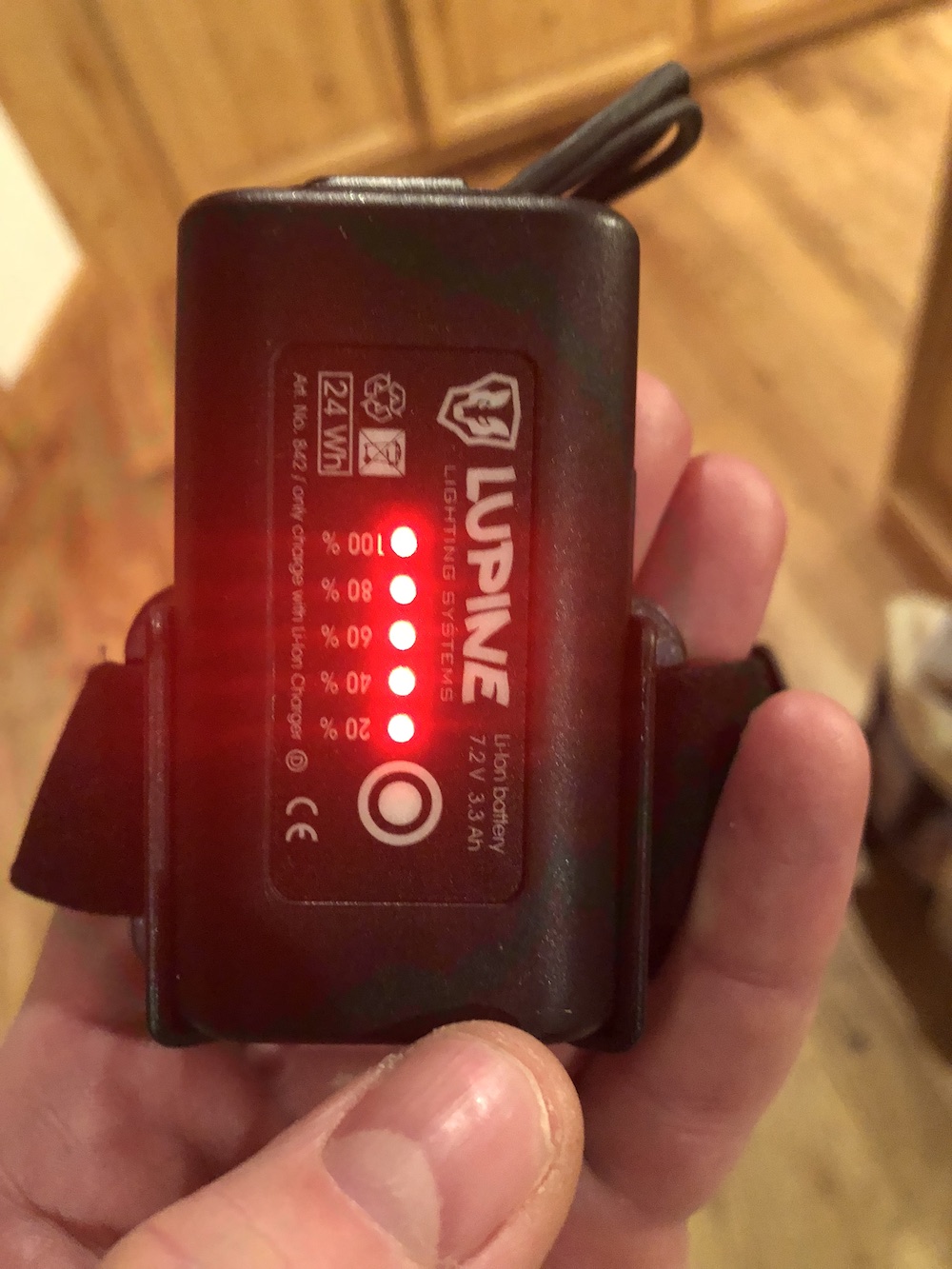
This is huge, as I can’t tell you the number of times that I was skiing home from work in Switzerland thinking, “I wonder if my light is going to last the whole way home.” Sometimes it did and sometimes it didn’t, and for those of you out there who’ve had this happen, you know firsthand that this is a real drag: your ski becomes more of a long, cold, slow walk, which is frustrating at many levels.
Next, this battery life gauge can also double as a tail light, so if you’re using this light as a headlamp for cycling, in a pinch you can forgo a dedicated tail light (I don’t recommend this AT ALL, but it’s nice to have this option in case of emergency or if your dedicated taillight fails, or most importantly, as just one more thing to keep you from getting run over.) So I love the utility but also the foresight (see, I warned you there were going to be a lot of these bad puns).
Speaking of cycling, another thing that I really love about this light is its versatility. This light can literally be the only light in your quiver (I also don’t recommend this, as are you going to always remember to have it in your car, your nightstand, etc? Of course not. Spend $29 Ebenezer Scrooge on a few backups), as it is so bright that it can also serve at your only light for night riding on technical mountain bike trails, remote road rides, or even just regular nighttime bike commuting. As is the case for the Neo, Lupine has a slew of handlebar, helmet, and headband mounts, so this light can very seamlessly move from head to helmet to bars and back again, all within seconds.
As if that weren’t enough the ‘R’ in Piko R stands for remote, so yes, this system also comes with a Bluetooth remote control. The funny thing here is that when I received my initial giant pile of parts from Lupine, I very quickly sifted though the menagerie and immediate create two piles, “What I need,” and “What I don’t.” Since the primary emphasis of this portion of the review is on skiing, it was my contention that a Bluetooth remote wrist strap was going to be largely superfluous. And as usual, for skiing, I was correct.
Where I probably would have missed the boat on this, however, was in the incredible utility of the remote for cycling — even for the bar-mount configuration, but in particular for the helmet-mount option, the remote proved to be amazing.
Every day I was out testing the gravel bike shown in Day 6, I wanted to put the bike through its paces on many different riding surfaces and daylight conditions. On the road when the sun was still up, I had the light in strobe mode to keep me from being killed by clueless and inconsiderate motorists. Once it started to get dark on the trails, I had’er on “Full burn,” as this was very technical riding, then finally on the commute home, I toggled it back to the medium setting to increase battery life and not blind oncoming cars. In reality, I toggled between all of these options a few times, so being able to do so at the touch of a button on the remote conveniently mounted on my hoods ala Campy Ergo shifting style was awesome.
I also did a few after-work, early evening transitioning into full darkness trail runs and again, the light was simply incredible. The fact that you have such a high top end is useful for more than just the obvious reasons, too, as such a high-power ceiling means that you can dial it back to a more “medium setting” (a very relative term) and still have way more candlepower than almost any other light does on full-send. This means a brighter light AND longer run times, which is the Holy Grail of headlamps.
While this is most definitely an expensive light, where the Piko really shines (sorry), is not only it’s total 1,800 lumen output, but also in its ratios. Its lumen/dollar ratio is extraordinary (5.4 lm/$, as compared to 3.27 lm/$ for the Neo and 3.0 lm/$ for the Petzl), it’s lumen/weight (32.7 lm/g) ratio is also amazing, so not only does it offer the most power at essentially the same weight, it is also the best value.
To put it bluntly, if I could only have one light, it would be this one. It’s little brother, the Neo, is great for skiing and still an amazing light, but for basically no more weight and just a little more dough-ray-me, you can use this light and this light alone for commuting, road riding, trail riding, skiing and of course, general all-around use. The fact that it is light enough to be worn as a headlamp, yet powerful enough to literally be your ONLY light for night mountain bike rides really is nothing short of incredible.
In summary, if you only need something to stick in your drink belt in case you slightly misjudge sunset and only occasionally get caught in the dark for the last few minutes of your ski, or, if you are like me and are both very gullible and very susceptible to peer-pressure and can therefore very easily be shamed into going for a much longer ski than you originally planned (we call this the J-Smu ski of shame), you should be able to limp back to the car with any of the Petzls with no problem. These are also very economical, excellent all-around lights for more stationary activities, you know, like writing letters (I will mail one America dollar to the first person who understands and appreciates that hilarious pun).
If you’re even a somewhat regular NND (Nighttime Nor-Dork), then you definitely need to go with the Lupine Neo at the very minimum and the Piko if you can afford it (or even better, shame someone else into buying it for you. Yes, I know, lots of ‘shame’ references in today’s column, but isn’t that what the holiday are all about, shame? And skiing. And in the best of all possible worlds, Dr. Pangloss, shame skiing.
And finally, for all of you fellow gear-maximalists out there, you know that you need the Piko, as that mo-fo rocks. You can crush the trails, the tracks and the roads and you’ll be glad you bucked up the extra hundy each and every night that you’re out there.
- 12 Days of FBD
- 12 Days of FBD Christmas
- combo hats
- Combo hats/lights
- combo lights
- FasterSkier's 12 Days of FBD
- FBD
- FBD Christmas
- L.L.Bean Pathfinder LED Cap
- Lighting Systems
- Lupine
- Lupine 2018 Piko headlamp
- Lupine Neo
- Lupine Neo X2
- Lupine Piko
- Lupine Piko 4
- Lupine Piko 4 Helmet Light System
- Petzel Tikka
- Petzl
- Petzl e+LITE
- skiing headlamp
- Tikka
- ultimate sports headlamp
Jon "Fast Big Dog" Schafer
Fast Big Dog is a paradoxically gregarious yet reclusive, self-absorbed mystic and world traveler. In addition to his calling to right the wrongs in the ski fashion and gear world, he also brings his style, wit and devilish charm to the Steamboat Springs Winter Sports Club as the Nordic High Performance Director and Worldwide Director of Morale and Awesomeness. Savor these articles while you can, as his Great Dane puppy may burn down his house at any moment, possibly making this his last transmission.




